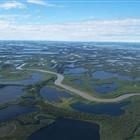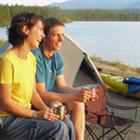With mystery and danger comes the raw, unspoiled beauty of one of the world’s last wilderness regions. Canada’s North—encompassing the Yukon, Northwest Territories and Nunavut—is home to white wolves, polar bears, massive walrus and giant bowhead whales up to 59 ft in length. Fly over the greatest caribou migrations in the world, Thule archaeological digs, vast wildlife preserves and inukshuks, stone figures pointing the way across tundra. In summer, golf, fish and dance at an outdoor music festival under the midnight sun.
The search for treasure fueled a frenzy of immigration to the Yukon during the Klondike Gold Rush in the late 1800s. The rush for ice-white diamonds, discovered in 1991 in the Northwest Territories, has brought a sparkling new city skyline to its capital city, Yellowknife. And in Nunavut’s capital, Iqaluit, on the edge of Frobisher Bay, treasured Inuit art is attracting its own frenzy of interest from around the globe. Come see it for yourself.
Breathe in the crisp Yukon air. Smell spruce sap and earthy tundra. Listen for the excited howls of husky sled dogs. Wander the landscape under the midnight sun or aurora borealis. Walk in the footsteps of northern pioneers, talk to the locals and discover the Yukon spirit.
This is a land of untamed wilderness, with outdoor adventures like no other. You'll be fascinated by caribou migrations, First Nations culture and the northern pioneer character. In summer, hike or paddle in spectacular Kluane National Park and Reserve; in winter, cross-country ski or snowmobile in this breathtaking location, part of a World Heritage Site. You'll want to photograph the mesmerizing black granite peaks, idyllic alpine lakes and subarctic tundra landscapes of Tombstone Territorial Park, or watch the swans and fish for Arctic grayling on M'Clintock Bay.
Board a plane from Whitehorse, Haines Junction or Dawson City to flightsee across this vast, captivating land. Or take a little longer with a road trip north from Dawson City up the Dempster Highway, crossing the Arctic Circle on your way to Inuvik in the Northwest Territories.
There are many activities that are perfectly suited for the Territory of Nunavut. Hiking, canoeing and camping enthusiasts will find the terrain ideal for their passion, while animal lovers can visit some of the most unique wildlife on the planet in our bird and wildlife sanctuaries.
Kayakers will of course know that kayaking is part of Inuit heritage and Nunavut offers one of the world’s most diverse sea-kayaking environments, as well as many experienced guides.
And for those who just like to watch, you’ll never find anything quite as amazing as standing on a Floe Edge watching icebergs after the ice breaks up.
Drum dancers and throat singers tell the same stories of hunts, travels, gods and beasts that were told a thousand years ago.
Inuit traditional games are based on hunting and survival skills. Bones, stones, thread – items found in ancient homesteads – become pieces in skill testing challenges. The Inuktitut language is the first language in Nunavut schools. Culture in this part of Canada is simply different from anywhere else in the world.
Everywhere you turn you encounter people living with traditions and customs completely different from those found anywhere else. It’s totally authentic, casual and wonderful.
Inuit in Nunavut are recognized internationally for their stone sculptures, fine art prints and fabric arts. Over 27% of the population is involved in the production of Inuit art. Every community has amazing, artists producing original works in stone, bone, cloth, skins, prints and paints. It is pure magic!
Northern foods will surprise you with their texture and flavours. Arctic Char (pipsi) is a wonderful example. You can have this salmon-like fish smoked, dried, cooked in a stew or baked. Caribou (mikku) meat has a very fine texture. Other foods can be exceptionally exotic.
In a land without wood for cooking, uncooked meats are common. Certain walrus and whale dishes are for the extremely adventurous only. Even seeing these unique foods prepared and eaten will be a cultural experience you’ll remember forever.
Imagine hiking in a National Park at the top of the world, where caribou spend the summer. Canoe a wild northern river few have ever seen. Hop a bush plane and go flightseeing over the Nahanni, the Mackenzie Delta, or Great Slave Lake's East Arm. Or relax aboard a jet boat, and travel a northern river to a secluded mountain lodge.
Drive our uncrowded roads and marvel at the wildlife. Our roadside parks and campgrounds welcome you with scenic waterfalls. Wood bison, moose and bears can be spotted right from the road. And rare birds from across the Americas nest here each summer.
Source: Canadian Tourism Commission, Nunavut Tourism, Northwest Territories Tourism

